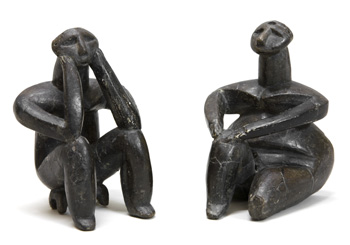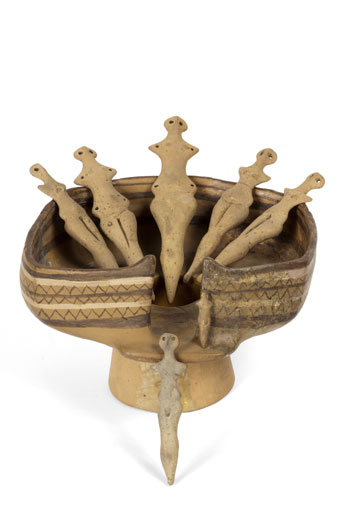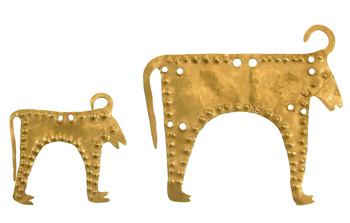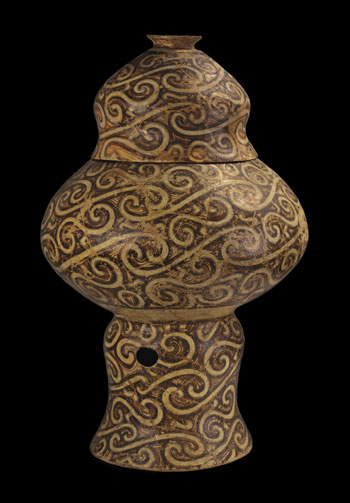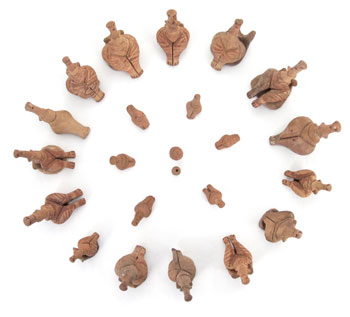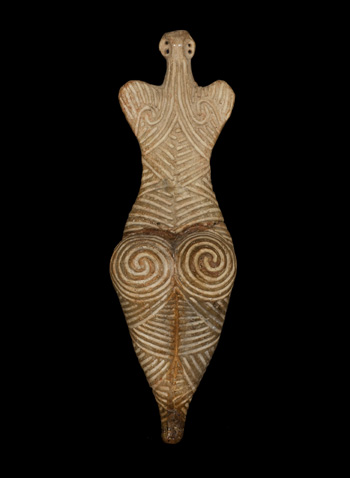May 18, 2010
I wasn't expecting such beautiful things, or such a range of bizarre items. My favourites were probably a pair of very Henry Moore figurines, made 7000-6600 years ago in Cernavoda: a man ("The Thinker") with his chin on his hands, and a woman sitting staring thoughtfully upwards with one knee raised. The lines are so contemporary they might have been made in 1960. Similarly, there's a splendid array of simply massive swirl-painted pots that might have been produced yesterday in St Ives - it's quite a shock to find that they're between 5 and 6 thousand years old. Firing them with today's technology would be a challenge: how on earth could people have managed it on a regular basis so long ago?
We simply don't know, is the cheery answer of most archaeologists. Nor can experts agree on the likely purpose of many of the intriguing items here. A vast pot has holes in its base indicating that it might have been used like a prehistoric samovar - but no traces of burning have been found on the inside. An enigmatic pottery basin-like structure was found with pierced dolls shaped like needles packed neatly inside. They look like weaving shuttles, but they could be pegs, weights or puppets (remarkably an almost identical set was found in Crete dated 2000 years later.) And why, why was a grave in the Varna Necropolis, Bulgaria, packed with minature golden grave goods - including tiny applique horns, and diadems too small for a human head - but no body?
The things we recognise make the baffling objects even more tantalising by their mute directness. A little fox - unquestionably a fox, it could not be anything else - peers up from animal figures ranged in one cabinet; another contains a little golden gavel like that of a modern judge. The female figurine chosen for the exhibition poster is even more intriguing in 3D - though flat-fronted, she has fabulous pointy buttocks like a 50s bra, lovingly engraved with detailed swirls. Someone actually did that with their actual hands 6000 years ago (and you can see what sort of mind he had). It's astonishing.
And that is what excites the archaeologists. Dr Vladimir Slavchev of the Varna Museum has no "favourite" find. Rather, for him, the most thrilling thing is achieving an image of the way these societies worked from a study of the context in which the artefacts were found. "It was a crucial moment," he says "in the history of these people, when the secret knowledge of metalwork was spreading through Europe and society as a result was starting to stratify." And why was this one settlement the richest known in the world of its time? He beams, his eyes alight with speculation. "That's a very interesting question. We don't know!"
The exhibition layout is good - plenty to look at in plenty of space. One of the main motivations behind the recent rebuild of the museum was the new temporary exhibition gallery; this exhibition is the first to be housed in the new facilities, which comprise two contrasting galleries - one intimate and one airy. A ceramic model building, mysteriously punctuated with large round holes, stands by an interior window of the exhibition space, catching the eye from the museum's central stairwell.
The labelling can be a bit confusing (read the bit your eye naturally skims past at the top in order to work out which area of the cabinet it's referring to), but having the pieces uncluttered by labels right next to them does add to the visual impact. Their layout now may bear no resemblance to their habitual layout then, but they have been deeply thought about: the pottery items have been delicately restored so that you can tell which bits are modern but the effect is as it would have been when they were first made. Strong lighting from below does make a little tricky to see the detail on a couple of displays, but otherwise everything is well-positioned. And, bravely, there is no top layer of glass between the viewer and the enormous pots.
This exhibition is a clear window into an unbelievably distant past. Those who get to see it will not forget it.
We simply don't know, is the cheery answer of most archaeologists. Nor can experts agree on the likely purpose of many of the intriguing items here. A vast pot has holes in its base indicating that it might have been used like a prehistoric samovar - but no traces of burning have been found on the inside. An enigmatic pottery basin-like structure was found with pierced dolls shaped like needles packed neatly inside. They look like weaving shuttles, but they could be pegs, weights or puppets (remarkably an almost identical set was found in Crete dated 2000 years later.) And why, why was a grave in the Varna Necropolis, Bulgaria, packed with minature golden grave goods - including tiny applique horns, and diadems too small for a human head - but no body?
The things we recognise make the baffling objects even more tantalising by their mute directness. A little fox - unquestionably a fox, it could not be anything else - peers up from animal figures ranged in one cabinet; another contains a little golden gavel like that of a modern judge. The female figurine chosen for the exhibition poster is even more intriguing in 3D - though flat-fronted, she has fabulous pointy buttocks like a 50s bra, lovingly engraved with detailed swirls. Someone actually did that with their actual hands 6000 years ago (and you can see what sort of mind he had). It's astonishing.
And that is what excites the archaeologists. Dr Vladimir Slavchev of the Varna Museum has no "favourite" find. Rather, for him, the most thrilling thing is achieving an image of the way these societies worked from a study of the context in which the artefacts were found. "It was a crucial moment," he says "in the history of these people, when the secret knowledge of metalwork was spreading through Europe and society as a result was starting to stratify." And why was this one settlement the richest known in the world of its time? He beams, his eyes alight with speculation. "That's a very interesting question. We don't know!"
The exhibition layout is good - plenty to look at in plenty of space. One of the main motivations behind the recent rebuild of the museum was the new temporary exhibition gallery; this exhibition is the first to be housed in the new facilities, which comprise two contrasting galleries - one intimate and one airy. A ceramic model building, mysteriously punctuated with large round holes, stands by an interior window of the exhibition space, catching the eye from the museum's central stairwell.
The labelling can be a bit confusing (read the bit your eye naturally skims past at the top in order to work out which area of the cabinet it's referring to), but having the pieces uncluttered by labels right next to them does add to the visual impact. Their layout now may bear no resemblance to their habitual layout then, but they have been deeply thought about: the pottery items have been delicately restored so that you can tell which bits are modern but the effect is as it would have been when they were first made. Strong lighting from below does make a little tricky to see the detail on a couple of displays, but otherwise everything is well-positioned. And, bravely, there is no top layer of glass between the viewer and the enormous pots.
This exhibition is a clear window into an unbelievably distant past. Those who get to see it will not forget it.




